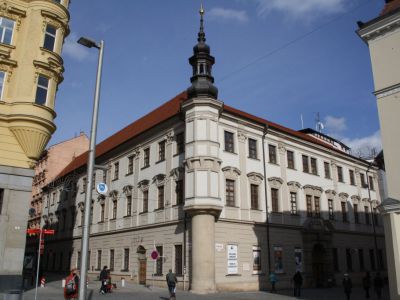
Etnografický Ustav MZM (Ethnographic Institute), Brno
The Ethnographic Institute of the Moravian Museum (Etnografický Ustav MZM), located in Brno, is a prominent cultural institution dedicated to the preservation and study of traditional Moravian culture. Housed in the Noble Palace (Palác Šlechtičen), a historical building that was severely damaged during World War II and later restored for cultural purposes, the Institute plays a key role in showcasing the rich folk traditions of the region from the 18th century to the present.
Founded in 1896 as the People's Science Department, the Ethnographic Institute is one of the oldest departments of the Moravian Museum (Moravské Zemské Muzeum), the second largest and second oldest museum institution in the Czech Republic. The Moravian Museum itself was established by the imperial decree of Francis I in July 1817 and currently holds over 6 million objects in its extensive collections, which span both the natural and social sciences.
The Ethnographic Institute's collections are vast, encompassing approximately 120,000 items that provide a comprehensive view of Moravian folk culture. These collections include traditional costumes, folk art, crafts, furniture, musical instruments, toys, photographs, films, and graphic art. Initially, the museum's focus was on agricultural production, reflecting the lifestyle of rural communities. However, as scholarly approaches evolved, the Institute's collection strategy shifted to emphasize traditional folk clothing and fine arts, recognizing these as vital elements of national identity.
Today, the Ethnographic Institute is recognized as the second-largest ethnographic museum in the Czech Republic. It systematically studies folk culture within the broader European context, paying particular attention to the material culture of Moravia and its minority groups. In addition to its role in research and preservation, the Institute actively engages the public through exhibitions, lectures, excursions, and youth programs, contributing to the ongoing appreciation and understanding of Moravian heritage.
Founded in 1896 as the People's Science Department, the Ethnographic Institute is one of the oldest departments of the Moravian Museum (Moravské Zemské Muzeum), the second largest and second oldest museum institution in the Czech Republic. The Moravian Museum itself was established by the imperial decree of Francis I in July 1817 and currently holds over 6 million objects in its extensive collections, which span both the natural and social sciences.
The Ethnographic Institute's collections are vast, encompassing approximately 120,000 items that provide a comprehensive view of Moravian folk culture. These collections include traditional costumes, folk art, crafts, furniture, musical instruments, toys, photographs, films, and graphic art. Initially, the museum's focus was on agricultural production, reflecting the lifestyle of rural communities. However, as scholarly approaches evolved, the Institute's collection strategy shifted to emphasize traditional folk clothing and fine arts, recognizing these as vital elements of national identity.
Today, the Ethnographic Institute is recognized as the second-largest ethnographic museum in the Czech Republic. It systematically studies folk culture within the broader European context, paying particular attention to the material culture of Moravia and its minority groups. In addition to its role in research and preservation, the Institute actively engages the public through exhibitions, lectures, excursions, and youth programs, contributing to the ongoing appreciation and understanding of Moravian heritage.
Want to visit this sight? Check out these Self-Guided Walking Tours in Brno. Alternatively, you can download the mobile app "GPSmyCity: Walks in 1K+ Cities" from Apple App Store or Google Play Store. The app turns your mobile device to a personal tour guide and it works offline, so no data plan is needed when traveling abroad.
Etnografický Ustav MZM (Ethnographic Institute) on Map






Sight Name: Etnografický Ustav MZM (Ethnographic Institute)
Sight Location: Brno, Czech Republic (See walking tours in Brno)
Sight Type: Museum/Gallery
Sight Location: Brno, Czech Republic (See walking tours in Brno)
Sight Type: Museum/Gallery
Walking Tours in Brno, Czech Republic
Create Your Own Walk in Brno
Creating your own self-guided walk in Brno is easy and fun. Choose the city attractions that you want to see and a walk route map will be created just for you. You can even set your hotel as the start point of the walk.
Functionalist Architecture in Brno
Functionalist architecture, a style that sought to meet the needs of the rapidly evolving industrial society, emerged in Europe in the wake of World War I.
After Czechoslovakia gained independence in 1918, Brno, the second-largest city in the country, developed rapidly both economically and politically. Its architecture reflected a modernist approach that prioritized functionality and... view more
Tour Duration: 1 Hour(s)
Travel Distance: 1.5 Km or 0.9 Miles
After Czechoslovakia gained independence in 1918, Brno, the second-largest city in the country, developed rapidly both economically and politically. Its architecture reflected a modernist approach that prioritized functionality and... view more
Tour Duration: 1 Hour(s)
Travel Distance: 1.5 Km or 0.9 Miles
Brno Introduction Walking Tour
Brno is the second-largest city in the Czech Republic. Located in the South Moravian Region, it is the center of Czech's judiciary and the former capital of Moravia.
Brno is known for its exhibition center, one of the largest in Europe. It is also known for its international fireworks competition, Fire of Brno. The long history of fireworks and pyrotechnics are seen in the Spilberk Castle... view more
Tour Duration: 2 Hour(s)
Travel Distance: 2.7 Km or 1.7 Miles
Brno is known for its exhibition center, one of the largest in Europe. It is also known for its international fireworks competition, Fire of Brno. The long history of fireworks and pyrotechnics are seen in the Spilberk Castle... view more
Tour Duration: 2 Hour(s)
Travel Distance: 2.7 Km or 1.7 Miles


